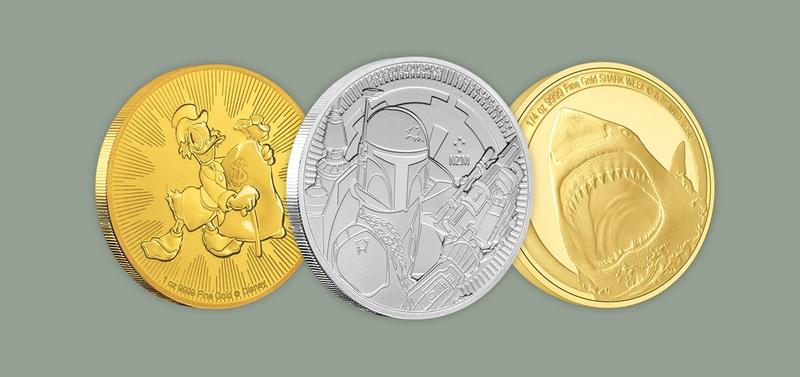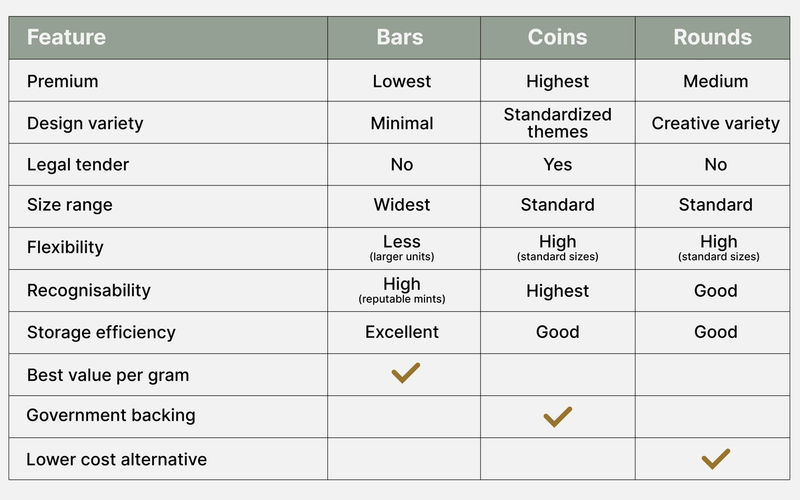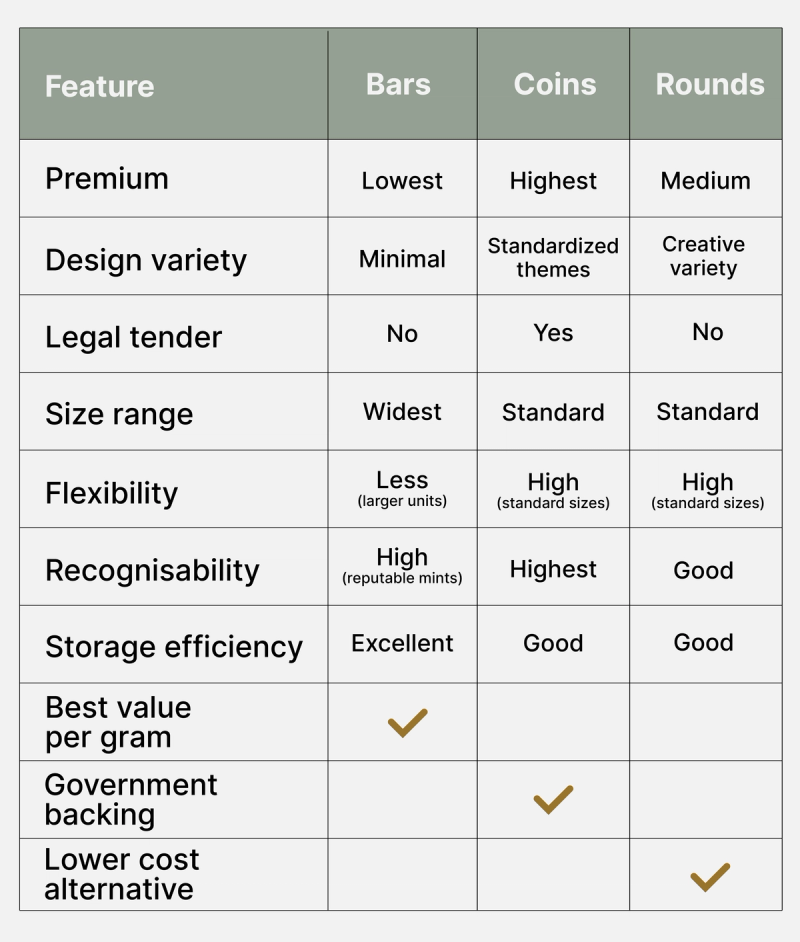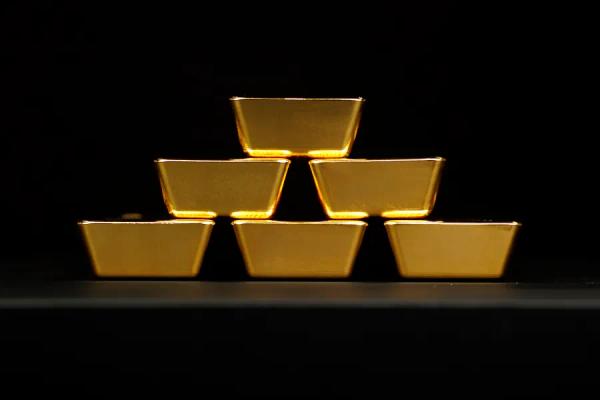When investing in precious metals, one of your first decisions is choosing the format: bars, coins, or rounds. Each option has distinct characteristics, and understanding the differences helps you select products that align with your goals, budget, and storage preferences.
There's no universally "best" format — the right choice depends on your individual circumstances. Here's what you need to know about each option.


What Are Bullion Bars?
Bullion bars are rectangular pieces of gold or silver produced by refineries or mints. They're valued purely for their metal content and typically carry lower premiums than coins.
Common sizes:
- Gold: 1g, 5g, 10g, 20g, 50g, 100g, 1oz, 10oz, 1kg
- Silver: 1oz, 10oz, 100oz, 250g, 500g, 1kg, 5kg
Key characteristics:
- Lower premiums — Generally the most cost-effective way to buy bullion by weight
- Simple design — Stamped with weight, purity, manufacturer mark, and often a serial number
- Efficient storage — Stackable and space-efficient, especially larger bars
- Wide recognition — Accepted globally when from reputable manufacturers
Best suited for:
- Investors focused on acquiring maximum metal for their budget
- Larger purchases where premium efficiency matters
- Long-term holding and storage
- Those prioritizing metal content over design or collectability
Considerations:
- Less visually distinctive than coins
- Larger bars can be less flexible when selling (typically sold as complete units)
- May require authentication testing when selling privately (though certified bars from recognized mints are readily accepted by dealers)


What Are Bullion Coins?
Bullion coins are minted by government authorities and carry legal tender status in their country of issue. While valued primarily for metal content, coins often have higher premiums due to design, minting quality, and recognisability.
Popular examples:
- Gold: Canadian Maple Leaf, American Eagle, Australian Kangaroo, South African Krugerrand
- Silver: Canadian Maple Leaf, American Eagle, Austrian Philharmonic, British Britannia
Common sizes:
- Gold: 1/10oz, 1/4oz, 1/2oz, 1oz
- Silver: 1oz, 2oz, 5oz, 10oz, 1kg
Key characteristics:
- Legal tender status — Official face value in the issuing country
- Government backing — Manufactured by national mints with guaranteed weight and purity
- Detailed designs — Often feature national symbols, wildlife, or cultural themes
- High recognisability — Widely known and easily authenticated
- Updated annually — Many coins feature year-specific designs
- Security features — Some include anti-counterfeiting technology
Best suited for:
- Investors who value recognisable, trusted products
- Those making smaller or more flexible purchases
- People interested in design alongside metal content
- Investors seeking high liquidity and easy resale
- Gift giving or building themed collections
Considerations:
- Higher premiums per ounce than bars
- Premium differences exist between different sovereign mints
- Some coins carry numismatic (collectible) value beyond metal content, though this applies mainly to proof or limited editions


What Are Bullion Rounds?
Rounds are coin-shaped pieces produced by private mints. They're not legal tender but offer similar convenience and recognisability to coins, typically with lower premiums.
Common sizes:
- Gold: 1/10oz, 1/4oz, 1/2oz, 1oz
- Silver: 1/2oz, 1oz, 2oz, 5oz
Key characteristics:
- Coin-like format — Round shape, similar size to coins
- Private mint production — Made by refineries and private mints like New Zealand Mint
- Varied designs — More creative freedom than government coins
- No face value — Not legal tender, valued solely for metal content
- Lower premiums than coins — More affordable than government-issued equivalents
- Good recognisability — Standard weights and clear markings
Best suited for:
- Budget-conscious investors seeking coin-format convenience
- Those who appreciate design variety
- Investors prioritizing metal content over legal tender status
- Regular purchasers building positions over time
- Gift giving when price is a consideration
Considerations:
- Slightly less recognized globally than sovereign coins
- No legal tender status
- Resale may be marginally easier with government coins, though reputable private mint rounds are readily accepted by dealers
Direct Comparison: Bars, Coins, and Rounds


Key Factors in Your Decision
1. Premium vs. Metal Content
If your primary goal is acquiring the maximum amount of precious metal for your budget, bars typically offer the best value. The simpler manufacturing process and higher production volumes result in lower premiums.
However, premium isn't the only consideration — liquidity, recognisability, and flexibility also matter for many investors.
2. Liquidity and Resale Flexibility
Smaller denominations (coins and rounds) offer more flexibility when selling:
- You can sell portions of your holdings without liquidating everything
- Standard weights (1oz, 10oz) are universally recognized
- Smaller units are easier to trade in private transactions
Larger bars are typically sold as complete units, though dealers like New Zealand Mint offer straightforward buyback programs regardless of format.
3. Storage Considerations
Bars are the most space-efficient, particularly in larger sizes. A 1kg gold bar occupies minimal space relative to its value.
Coins and rounds require more storage space per ounce but are easier to organize, count, and transport in smaller quantities.
Consider your storage setup:
- Home storage — Smaller coins and rounds are easier to secure in multiple locations
- Professional vaulting — Space efficiency of bars reduces storage costs
4. Authentication and Verification
Government coins are often easier to authenticate due to:
- Widely known specifications
- Built-in security features
- Standardized weights and dimensions
Quality bars from reputable mints like New Zealand Mint come with:
- Serial numbers
- Assay certificates
- Tamper-evident packaging
- Clear manufacturer markings
Rounds from established private mints are also readily verified by weight, dimensions, and manufacturer reputation.
5. Budget and Purchase Frequency
Your buying pattern affects format choice:
Regular smaller purchases?
- Coins and rounds allow gradual accumulation
- Easier to fit purchases into monthly budgets
- Flexibility to adjust quantities based on cash flow
Larger one-time purchases?
- Bars offer better value through lower premiums
- Single transactions reduce handling and shipping costs
- More efficient for significant capital allocation
6. Purpose and Time Horizon
Long-term wealth preservation:
- Bars maximize metal content for the budget
- Lower premiums mean more of your capital goes into metal
- Space-efficient storage for extended holding periods
Flexible liquidity needs:
- Coins and rounds offer easier partial liquidation
- Standard denominations simplify transactions
- Higher recognisability supports faster resale
Gifting or passing to heirs:
- Coins carry emotional appeal and aesthetic value
- Smaller denominations are easier to divide among beneficiaries
- Recognizable brands add confidence for recipients
Can You Mix Formats?
Many investors hold a combination of formats to balance different priorities:
Example portfolio approach:
- 70% in bars — Maximizing metal content with lower premiums
- 30% in coins — Providing liquidity and flexibility
This approach captures the cost efficiency of bars while maintaining readily tradable smaller units.
There's no requirement to choose just one format — your holdings can evolve based on goals, budget, and circumstances.
What New Zealand Mint Offers
We produce and sell investment-grade products across all three categories:
Gold and Silver Bars:
- .9999 fine gold / .999 fine silver
- Range of sizes from 1g to 1kg
- Serial numbered with assay certificates
- Sealed protective packaging
Legal Tender Coins:
- Official coins from various national mints
- Guaranteed weight and purity
- Iconic designs and year-specific releases
- Recognized globally
Bullion Rounds:
- New Zealand Mint-produced designs
- Same purity standards as bars (.9999/.999)
- Varied themes and artwork
- Competitive pricing
All products include:
- Clear purity markings
- Detailed specifications
- Transparent pricing showing premium over spot
- Secure packaging options
- Full documentation
Making Your Choice: A Simple Framework
Choose bars if:
✓ You're focused on metal content and value per ounce
✓ You're making larger purchases ($5,000+)
✓ You plan to hold long-term with minimal trading
✓ Storage space is limited
✓ You're comfortable with larger single-unit values
Choose coins if:
✓ You value global recognition and government backing
✓ You prefer flexibility in buying and selling
✓ You're making smaller, regular purchases
✓ You appreciate design and numismatic aspects
✓ You want maximum liquidity and easy authentication
Choose rounds if:
✓ You want coin-format convenience at lower premiums
✓ You're building a position gradually on a budget
✓ Design variety appeals to you
✓ You're focused on metal content but prefer smaller denominations
✓ You want flexibility without paying coin premiums
Questions to Ask Yourself
Before deciding, consider:
- What's my primary goal? — Wealth preservation, gradual accumulation, or portfolio diversification?
- How much am I investing? — Larger budgets benefit more from bar premiums
- How long do I plan to hold? — Longer timeframes suit larger, more efficient formats
- How important is flexibility? — Need to sell portions or prefer all-or-nothing?
- Where will I store it? — Home storage favors smaller units; vaulting favors efficiency
- Do I value design or just metal? — Aesthetic preference may justify coin premiums
Getting Started
Not sure which format suits you? Our team can help you:
- Compare premiums across formats
- Understand size options and pricing
- Discuss storage solutions
- Calculate quantities based on your budget
- Answer specific questions about products
We're here to provide information and options — helping you make choices that fit your individual situation.
Key Takeaways
- Bars offer the lowest premiums and maximum metal content per dollar
- Coins provide recognisability, flexibility, and government backing
- Rounds balance coin-like convenience with lower premiums
- Most investors can benefit from holding multiple formats
- Your choice should reflect your goals, budget, and time horizon
No single format is inherently better — the right choice depends on your individual circumstances and priorities.
Important Information
This article is for educational and informational purposes only and does not constitute financial, investment, or tax advice. The format you choose should reflect your personal circumstances, goals, and preferences.
Before making any investment decision, consider seeking independent advice from a licensed financial professional.
New Zealand Mint provides information and products but does not provide financial advice.
